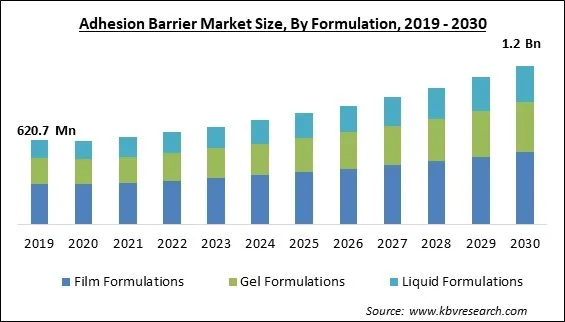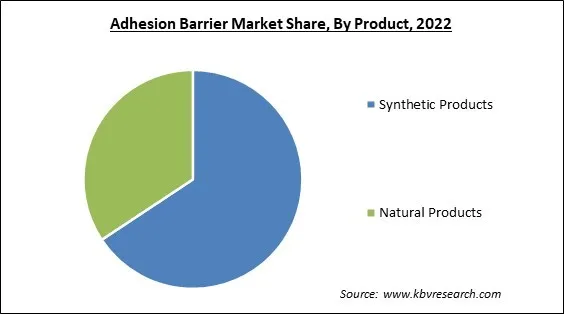The Global Adhesion Barrier Market size is expected to reach $1.2 billion by 2030, rising at a market growth of 7.2% CAGR during the forecast period.
Gynecological treatments use gel and film forms, such as ectopic pregnancy, ovarian cystectomy, and endometriosis surgery. Therefore, the Gynecological Surgeries segment registered $108.8 million revenue in the market in 2022. Cameras and robot-assisted devices are expensive equipment required for minimally invasive operations. Customers in developing nations that are price-sensitive are anticipated to adopt these devices. Adopting adhesion barriers is expected to be positively impacted by the slow adoption of minimally invasive techniques in developing countries. Some of the factors impacting the market are increase in road accident surgeries, increasing incidence of chronic diseases, and the less substitute methods of treatment.

The UN General Assembly has set the ambitious aim of halving traffic-related fatalities and injuries by 2030, according to the World Health Organization. Injury-related mortality on the road is the primary cause of death for children and young adults aged 5 to 29. More than 1.3 million people are killed annually in motor vehicle accidents. Over fifty percent of all road traffic fatalities involve vulnerable road users, cyclists, pedestrians, and motorcyclists. Adhesion formation is a significant post-surgical complication that requires additional surgical procedures for affected patients. Moreover, Chronic diseases, including cancer, endometriosis, and inflammatory bowel disease, are progressively increasing. According to the WHO, endometriosis globally impacts 10% (or 190 million) of women and girls of reproductive age. It is a chronic disease characterized by severe, life-altering pain during menstruation, sexual intercourse, bowel movements, and/or urination, chronic pelvic pain, abdominal bloating, nausea, fatigue, occasionally melancholy, anxiety, and infertility. Laparoscopic surgery (using a small camera to visualize inside the body) permits doctors to keep small incisions. Consequently, the market will grow due to a rise in the number of surgeries performed globally increases will increase the significance of these products and increase in the incidence of these diseases.
However, there are several alternative treatment options for eliminating adhesions without adhesion barriers. Medication, exercise, physical therapy, lifestyle modifications, and soft tissue mobilization are alternatives to surgery. Medications are frequently the first treatment for acute pain and a component of the treatment for chronic pain. Additionally, the majority of adhesions have no symptoms and don't require any sort of therapy. Additional operations will only increase adhesions. Because of this, unless blockages continue to cause symptoms, the healthcare professionals try to avoid surgery. A portion of individuals, however, prefer alternatives to adhesion barriers because, in most instances, they do not cause any issues, and there are a variety of available alternatives. In light of this, the market may experience slow expansion.
Furthermore, due to the COVID-19 pandemic's widespread distribution, the world's healthcare systems were under pressure. The COVID-19 pandemic had a negative effect on the market. Numerous clinics and hospitals all around the world were reconfigured to boost hospital capacity for COVID-19 patients. Nonetheless, it caused supply chain disruptions and put enormous pressure on the healthcare sector to meet the rising demand for patients with coronavirus infections. This resulted in a significant reduction in the demand for adhesion barriers.
By product, the market is segmented into synthetic products and natural products. The cost-effectiveness of synthetic adhesion barriers is anticipated to boost segment sales. In addition, the segment's dominance is predominantly attributable to the commercial availability of synthetic adhesion barriers. Postoperative complications such as adhesions can prolong hospital stays, lead to the need for additional surgeries, and increase recovery times.

Based on application area, the market is classified into gynecological surgeries, general/abdominal surgeries, orthopedic surgeries, cardiovascular surgeries, neurological surgeries, urological surgeries, reconstructive surgeries, and others. The cardiovascular surgeries segment procured a promising growth rate in the market in 2022. According to WHO, 17.9 million people die from cardiovascular diseases (CVDs), the leading cause of death globally. The primary factors driving growth in this segment are the increasing prevalence of heart-related disorders and the expanding use of adhesion barriers in cardiovascular surgery.
Based on formulation, the market is fragmented into film formulations, gel formulations, and liquid formulations. In 2022, the film formulations segment dominated the market with maximum revenue share. The wide availability of film-form adhesion barriers and the strong evidence demonstrating their efficacy and safety are two factors that contribute to this segment's significant market share. Compared to gel- and liquid-form adhesion barriers, surgeons have adopted film-form adhesion barriers more frequently due to the convenience of their use.
By end user, the market is categorized into hospitals & clinics, ambulatory surgical centers, and others. In 2022, the hospitals and clinics segment led the market by generating the highest revenue share. After surgical procedures, adhesion barriers are frequently used to reduce the risk of adhesion formation. Usually, hospitals employ a diverse team of medical professionals, including surgeons, anesthesiologists, nurses, and support staff, specializing in different aspects of surgery and patient care.
| Report Attribute | Details |
|---|---|
| Market size value in 2022 | USD 675.2 Million |
| Market size forecast in 2030 | USD 1.2 Billion |
| Base Year | 2022 |
| Historical Period | 2019 to 2021 |
| Forecast Period | 2023 to 2030 |
| Revenue Growth Rate | CAGR of 7.2% from 2023 to 2030 |
| Number of Pages | 364 |
| Number of Table | 580 |
| Report coverage | Market Trends, Revenue Estimation and Forecast, Segmentation Analysis, Regional and Country Breakdown, Companies Strategic Developments, Company Profiling |
| Segments covered | Product, Formulation, Application, End Use, Region |
| Country scope | US, Canada, Mexico, Germany, UK, France, Russia, Spain, Italy, China, Japan, India, South Korea, Singapore, Malaysia, Brazil, Argentina, UAE, Saudi Arabia, South Africa, Nigeria |
| Growth Drivers |
|
| Restraints |
|
Region-wise, the market is analyzed across North America, Europe, Asia Pacific and LAMEA. In 2022, the North America region led the market by generating the highest revenue share. The region's established healthcare infrastructure, expanding surgical procedures, and growing awareness of the effects of adhesions on health all support market expansion. Moreover, the region's key market participants and technological advances fuel the market's development. The rapid economic development of the US and Canada, along with the existence of a universal healthcare coverage policy, has increased the accessibility of citizens to various healthcare facilities.
Free Valuable Insights: Global Adhesion Barrier Market size to reach USD 1.2 Billion by 2030
The market research report covers the analysis of key stakeholders of the market. Key companies profiled in the report include Sanofi S.A., Becton Dickinson and Company, Baxter International, Inc. (Hill-Rom Holdings, Inc.), Johnson & Johnson, Anika Therapeutic, Inc., FzioMed, Inc., MAST Biosurgery USA, Inc. (MAST Biosurgery AG), Innocoll Biotherapeutics N.A. Inc., Luna Innovations, Incorporated and Integra LifeSciences Holdings Corporation.
By Application Area
By Formulation
By Product
By End User
By Geography


This Market size is expected to reach $1.2 billion by 2030.
Surge in road accident surgeries are driving the Market in coming years, however, Availability of substitute methods of treatment restraints the growth of the Market.
Sanofi S.A., Becton Dickinson and Company, Baxter International, Inc. (Hill-Rom Holdings, Inc.), Johnson & Johnson, Anika Therapeutic, Inc., FzioMed, Inc., MAST Biosurgery USA, Inc. (MAST Biosurgery AG), Innocoll Biotherapeutics N.A. Inc., Luna Innovations, Incorporated and Integra LifeSciences Holdings Corporation.
The Synthetic Products segment is generating the highest revenue in the Market by Product in 2022; thereby achieving a market value of $724.1 million by 2030.
The General/Abdominal Surgeries segment is leading the Market by Application Area in 2022; thereby, achieving a market value of $261.2 million by 2030.
The North America region dominated the Market by Region in 2022 and would continue to be a dominant market till 2030; thereby, achieving a market value of $402.4 million by 2030.
Our team of dedicated experts can provide you with attractive expansion opportunities for your business.

